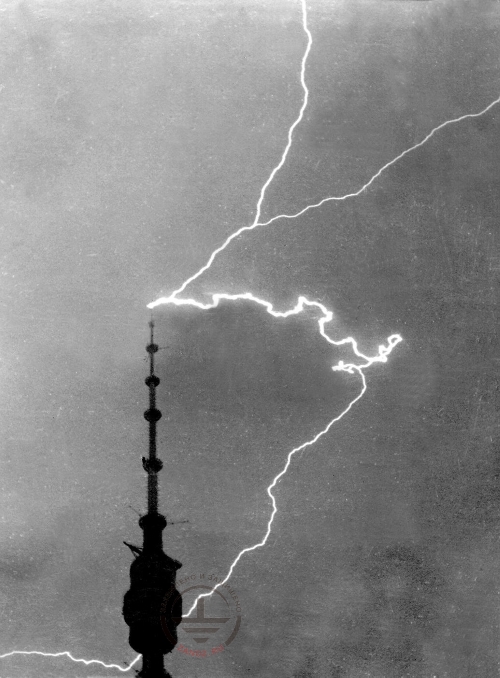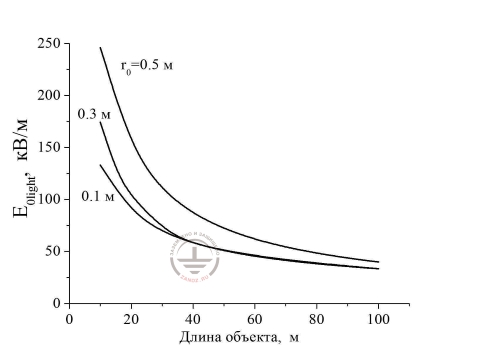The second part of the article "Lightning protection of aircrafts"
It is not unexpected for the specialists, because something similar was many times observed for on-ground high-rise constructions. It was set that with the increase of the object higher than 200 m, the number of downstream lightnign strikes into it (they start from a thunderstorm cloud) do not increase. But the number of upstream lightning, which originate from the structure's top and uprush to a thunderstorm cloud, increases. For example, for Ostankino TV-tower in Moscow, their share is about 90%, - 25-27 strikes per year (fig. 3).
The mechanism of upstream lightning origin is clear to the specialists and has been well analyzed. During a thunderstorm, the electric field at the undisturbed ground surface can grow to 20-40 kW/m. Along the tower ~ 500 m high it can achieve 10-20 mW. The field cannot exist inside the conducting body. All the induced charge is pushed to the surface to the top, creating an exclusively strong electric field sufficient for the origin and development of the lighting channel.

fig. 3. Static picture of the upstream lightning into the Ostankino tv-tower
Sizes of a modern airplane are significantly smaller, but it is close to a thunder cloud, where electric field can grow to 400-500 kW/m, much higher than at the ground surface. Besides, on-ground constructions are immovable. A cloud of a corona spacial charge is created above them in the elctric field of a thunder cloud. It screens the top of the object, delaying the start of ionization processes. The spacial charge is not accumulated in front of an aircraft. The speed of ions drift in the corona discharge significantly lags the aircraft flying speed. In fact, for normal conditions at the typical mobility of the most energetic ionsμi ≈ 1,5×10-4 m2(W s)-1 the speed of their drift can increase, let's say, up to vi = 100 m/s in the electric field
 (1)
(1)
It can happen only close to the charged cell of a thunder cloud, which an aircraft is strictly prohibited to approach according to the flight rules. That is why, it won't have a screening cloud of corona ions, and it means nothing will disturb the upstream lightning leader start.
Here we will again talk about the bipolar process. At the start of a positive leader from the nose part of the fuselage and its development in the directon of a negatively charged cell of a thunder cloud there will appear a negative leader from the tail, which will move to the ground surface or to any other positively charged thunder cell. A similar situaton is possible for the ends of the wings. The collage in fig. 4 illustrates the situation described.
The process is physically clear and modeled for air crafts of different dimensions at a different flying height. Calculated data in fig. 5 allow to estimate the threshold strength of the electric field in the atmosphere, sufficient to initiate the lightning discharge from the object of the fixed height in the air of normal density. As you can see, the results obtained depend on the equivalent radius of curve of start place of gas discharge process r0. It is consistent, because electric field there should necessarily be sufficient for air ionization.

fig. 5. Dependence of the atmosphere threshold field on the length of the air craft at normal conditions
It is necessary to pay attention at the fact, that in order to initiate lightning a large airplane must not necessarily approach a thunderstorm cell with the voltage of 400-500 kW/m. Lightning can get along with a weaker field. Thunder clouds are not required for its initiation. Electric charges of ordinary cumulus, which doesn't produce characteristic flash exposure on the screen of the radiolocation, are quite enough. The situation is not pleasant for the crew, because they lack preliminary warning about lightning danger.
E. M. Bazelyan, DEA, professor
Energy Institute named after G.M. Krzyzanowski, Moscow
Read more "3. Detector of a thunderstorm danger"
See also:
- Useful materials for grounding and lightning protection designers
- Free webinars with the leading industry experts
- Real-life examples of grounding and lightning protection calculations
Related Articles:
 Lightning protection of residential and public buildings - answers to frequently asked questions in the design
Lightning protection of residential and public buildings - answers to frequently asked questions in the design
 Lightning Protection of Large Territories: Parks, Grounds, Plant Territories. Page 1
Lightning Protection of Large Territories: Parks, Grounds, Plant Territories. Page 1
 Lightning Protection of Large Territories: Parks, Grounds, Plant Territories. Page 2
Lightning Protection of Large Territories: Parks, Grounds, Plant Territories. Page 2
 Lightning Protection of Large Territories: Parks, Grounds, Plant Territories. Page 3
Lightning Protection of Large Territories: Parks, Grounds, Plant Territories. Page 3

